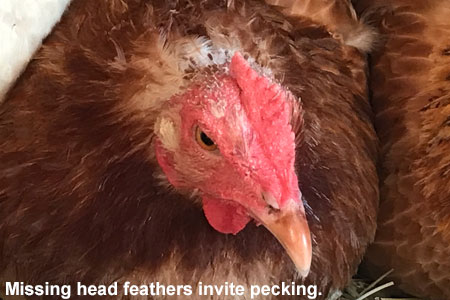
Cannibalism appears in several forms. But they all start in the same basic way. One bird is attracted to peck another. That, in turn, attracts others to join in. Many different conditions can cause cannibalism in chickens.
Cannibalism Triggers
The following conditions, alone or in combination, may trigger cannibalism:
- Chicks raised in a brooder, rather than under a mother hen
- Chicks kept in a brooder with a hardware cloth floor
- Crowding, especially with fast-growing chicks that overfill available space
- Excessive heat without adequate ventilation
- Bright lights 24/7
- Insufficient roosting space
- Lack of exercise opportunities
- Frequent disruptions to the pecking order
- Feeders and drinkers too few or too close together
- Abrupt changes in ration palatability
- Ration too low in salt or protein
- Ration high in calories and low in fiber
- Ration (such as pellets) eaten too fast
- External parasites
- Bleeding injuries or missing feathers
- Too few or improperly designed nests
- Genetics
Genetic Connection
Some breeds, and strains within a breed, tend more toward cannibalism than others. Breeds with the strongest foraging instincts have the strongest tendency toward cannibalism. Especially so when they are confined without opportunities to satisfy their inherent need to forage.
Lightweight, high-strung breeds that frighten easily are also likely to develop cannibalistic behavior. They tend to relieve stress by pecking each other. Highly territorial aggressive chickens that constantly engage in peck-order fighting also tend toward cannibalism.
Preventing Cannibalism in the Brooder
Since cannibalism often begins in the brooder, head it off before it starts. Keep the brooder from becoming overheated or crowded. Instead of lights for warmth, use an infrared heater panel. After the first week you can then turn off lights at night while still providing heat.
Brood chicks on a solid floor, rather than on hardware cloth. Increase living space as they grow and become more active. At the same time increase ventilation. Provide even more space when the weather turns warm.
Do not combine vastly different age groups in the brooder. The stronger, older birds will peck the weaker, younger ones.
Protein requirements change with age and season. And protein deficiency can lead to cannibalism. So take care to adjust rations as needed to ensure your chicks are getting sufficient protein.
Provide a large enough feeder to ensure each chick can eat its fill. If your flock size requires two or more feeders, space them far enough apart to avoid crowding and jostling. The same goes for drinkers.
Preventing Cannibalism in the Coop
Avoid continually introducing new birds into your flock. Constantly disrupting the pecking order leads to frequent fighting. And fighting easily escalates into cannibalism.
Furnish plenty of perch space. Perches help prevent pecking by giving chickens more places to get away from each other. Discourage pecking from below by making sure the lowest perch is at least 18 inches above the floor.
Provide suitable areas for dust bathing. And, in general, establish a rich environment. The goal is to encourage normal exploring, nesting, grooming, and foraging behavior. Chickens that are busy with normal activities are less likely to engage in cannibalistic pecking.
Patrol your coop and yard regularly. Look for broken wire or protruding nails that could cause bleeding wounds. Isolate and treat any injured chicken or one with reddened skin irritated by parasites.
Chickens are less likely to become cannibalistic when their diet is high in sources of insoluble fiber. Accordingly, include grains, bran, seeds, and dark leafy greens in the flock’s diet.
Certain forms of feed discourage cannibalism. Crumbles, for instance, take longer to eat than pellets. Mash is even better. Chickens that eat mash spend time searching through the particles for their favorite tidbits. Because they take longer to eat, they have less time to peck each other.
Similarly, use drinkers that encourage pecking. “I recommend drinking nipples,” says Jeff Smith of Cackle Hatchery®, “because chickens like to peck the shiny metal tips. That keeps them busy. At the same time they’re drinking lots of clean water, which is good for egg production.”
And that’s today’s news from the Cackle Coop.
Gail Damerow is author of The Chicken Health Handbook.

